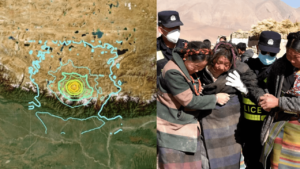The Philippine Atmospheric, Geophysical and Astronomical Services Administration (PAGASA) reported that Typhoon Gaemi intensified while moving northwestward over the Philippine Sea

On July 24, 2024, Typhoon Gaemi, coupled with the southwest monsoon, wreaked havoc across Manila and other parts of Luzon Island, causing severe flooding that left roads and neighborhoods underwater. The torrential rains and subsequent flooding have forced numerous evacuations, disrupted transportation, and halted daily activities in the region.
Impact on Manila and Surrounding Areas
The continuous downpours triggered by Typhoon Gaemi, combined with the southwest monsoon, resulted in extensive flooding across the Philippine capital, Manila, and many areas of Luzon Island. The floods, knee-deep in some regions, led to the evacuation of residents near Manila Bay and rivers to safer locations. Coastal areas in central and southern parts of the Philippines were also evacuated as a precautionary measure.
The Philippine Atmospheric, Geophysical and Astronomical Services Administration (PAGASA) reported that Typhoon Gaemi intensified while moving northwestward over the Philippine Sea, with wind speeds reaching 155 kilometers per hour and gusts up to 190 kilometers per hour. PAGASA warned that the typhoon would continue to dump heavy rain throughout the day, increasing the risk of further flooding and rain-induced landslides.
SUGGESTED: Typhoon Gaemi Prompts Highest Alert in China as Taiwan Prepares for Landfall
Government Response and Public Safety Measures
In response to the severe flooding, the Philippine government suspended classes at all levels and closed government offices in the national capital region. Both the Philippine Senate and the House of Representatives suspended their sessions. Local authorities worked tirelessly to evacuate residents from high-risk areas, ensuring their safety amid the rising floodwaters.
The flooding made many roads in the capital region impassable, stranding commuters who had ventured out early in the morning. Reports indicated that some vehicles stalled while attempting to navigate the submerged streets, adding to the chaos. The Ninoy Aquino International Airport faced significant disruption, with at least 16 flights canceled as a result of the adverse weather conditions.
Personal Stories and Struggles
The flooding brought daily life to a standstill for many Filipinos. People were seen swimming, driving, and wading through deep floodwater in an attempt to reach their destinations. Footage from various parts of Manila showed residents braving the knee-deep waters, highlighting the severity of the situation. Despite the challenges, the resilience and determination of the Filipino people were evident as they navigated the flooded streets.
One particularly concerning incident involved a 14-year-old boy who went missing after wading through floodwaters in Rizal province, east of Manila. The search for the boy continues as local authorities and volunteers work together to locate him. This tragic event underscores the dangers posed by the flooding and the urgent need for effective disaster response measures.
Economic and Infrastructural Impact
The economic impact of Typhoon Gaemi’s flooding is expected to be significant. The closure of businesses, government offices, and schools, along with the disruption of transportation and flight cancellations, will likely result in substantial financial losses. The destruction of properties, including a colony of shanties near Manila Bay, adds to the economic burden faced by the affected communities.
The Philippines, an archipelago prone to tropical cyclones, experiences an average of 20 typhoons annually. These natural disasters bring heavy rains, flooding, and strong winds, leading to casualties and widespread damage to crops and properties. Typhoon Gaemi, the third major storm to hit the country this year, has once again highlighted the vulnerability of the Philippines to such extreme weather events.

Weather Forecast and Future Precautions
PAGASA has forecasted that Typhoon Gaemi will continue to bring heavy rainfall until Thursday, with moderate to intense rainfall expected in many areas of Luzon, the Visayas region, and northern Mindanao. The bureau has warned that flooding and rain-induced landslides are possible in these areas, urging residents to remain vigilant and take necessary precautions.
As Typhoon Gaemi is expected to exit the Philippines by Wednesday night or early Thursday, the focus will shift to recovery and rebuilding efforts. The government, along with various non-governmental organizations and community groups, will work to provide relief and support to those affected by the flooding. Ensuring the safety and well-being of residents remains a top priority as the country navigates through this challenging period.
Historical Context and Preparedness
The Philippines’ susceptibility to typhoons and tropical cyclones is well-documented. The country has a long history of dealing with such natural disasters, which have often resulted in significant loss of life and property. Over the years, efforts have been made to improve disaster preparedness and response mechanisms, but the recurring nature of these events continues to pose challenges.
In light of Typhoon Gaemi’s impact, it is crucial to reflect on the lessons learned from previous disasters and enhance existing strategies to mitigate the effects of future storms. Strengthening infrastructure, improving early warning systems, and promoting community awareness and preparedness are essential steps in building resilience against typhoons and other extreme weather events.
Community and International Support
In times of crisis, the spirit of solidarity and support becomes more important than ever. The affected communities in Manila and Luzon have shown remarkable resilience and determination in the face of adversity. Local and international organizations are also stepping in to provide assistance, ensuring that those impacted by the flooding receive the help they need.
As recovery efforts begin, the support of the international community will play a vital role in helping the Philippines rebuild and recover. Humanitarian aid, financial assistance, and technical expertise will be crucial in addressing the immediate needs of the affected population and laying the groundwork for long-term recovery and resilience.
A Quick Review
Typhoon Gaemi has once again highlighted the vulnerability of the Philippines to natural disasters, particularly typhoons and tropical cyclones. The severe flooding in Manila and other parts of Luzon Island has caused significant disruption and hardship for the affected communities. As the country braces for more heavy rainfall and potential landslides, the focus remains on ensuring the safety and well-being of residents, providing relief and support, and rebuilding in the aftermath of the storm.
In conclusion, Typhoon Gaemi’s impact on the Philippines underscores the urgent need for continued efforts to enhance disaster preparedness and response measures. By learning from past experiences and working together, the country can build resilience and better withstand the challenges posed by future natural disasters.
Read Next:

The Psychology of Love: Why Valentines Day Matters More Epic Than You Think
Discover the psychology of love and why Valentines Day is more important than you think. Learn how love impacts the brain, strengthens relationships, and boosts

Premier League Highlights: Arsenal Humiliate Man City 5-1, Spurs and Palace Secure Crucial Wins
Arsenal demolished Manchester City 5-1 in a statement premier league highlights win, reigniting their title hopes. Meanwhile, Crystal Palace stunned Man United 2-0, and Tottenham

How Budget 2025 Impacts the Indian Middle-Class: Major Tax Benefits and Glaring Omissions
Budget 2025 offers major tax relief to the middle class, including zero tax on incomes up to ₹12 lakh. However, it misses out on incentives

Degrees vs Employability: Why “Highly Qualified Degree Holders” Struggle to Find Jobs While “Less Qualified Individuals” Get Hired Faster!
Many highly qualified individuals struggle to secure jobs, while less qualified candidates get hired quickly. This Degrees vs Employability paradox is caused by employer preferences,

The Power of Mindset: Why Looking Poor Doesn’t Make You Poor, but Thinking Poor Does!
Discover why looking poor doesn’t define your wealth but thinking poor does. Learn the power of mindset and how a growth-oriented mindset can lead to

Overthinking: How It’s Damaging Today’s Youth – Causes and Cure in 2025
Understanding how overthinking is silently damaging today’s youth, from its causes rooted in societal pressure and social media to its long-term effects on mental health.

Netaji Subhash Chandra Bose: An Epitome of Epic Leadership
Discovering the incredible life of Netaji Subhash Chandra Bose, a leader whose vision, courage, and determination redefined India’s freedom struggle. Explore his leadership qualities, ideology,

Global News Headlines Today: From Gaza Ceasefire to Blue Origin’s Massive 2025 Milestone
Explore today’s top global news headlines, from the Gaza ceasefire and Blue Origin’s historic spaceflight to Apple losing its top spot in China’s smartphone market.

The Hidden Danger of Social Media Nudity: A Threat to Today’s Youth in 2025
Understanding how social media nudity is impacting the youth and their future potential. Learn about the risks of unregulated content, cultural sensitivities, and solutions for

FA Cup 2024: Manchester United Survive Arsenal Test to Advance in FA Cup Fourth Round
Manchester United defeated Arsenal in a thrilling FA Cup third-round encounter, with Atlay Bayindir’s heroics sealing the win. Read about key moments, standout performances, and

Supercopa de España: Barcelona Dominate Real Madrid 5-2 to Claim Supercup
Barcelona delivered a stunning 5-2 victory over Real Madrid in the Supercopa de España final. Read about the key moments, star players, and the significance

Global News Highlights Today: India’s Metro Milestone, US Aid Shift, iOS Stunning Updates and More!
Explore today’s global news highlights, including the Tibet earthquake, political tensions in South Korea, LA wildfires, US aid shifts, and India’s metro milestone. Stay informed

The Power of Keeping Plans Private in 2025: Why Silence is the Key to Achieving Your Dreams!
Discover why keeping plans private is crucial for achieving your dreams. Learn how silence boosts focus, protects momentum, and helps you achieve success without distractions

Rolls-Royce Ghost Series II Arrives in India 2025: Elegance Meets Stunning Innovation
Discover the all-new Rolls-Royce Ghost Series II launched in India, priced from ₹8.95 crore. Explore its stunning design, luxurious interior, enhanced tech features, and powerful

Global News Highlights: Earthquakes in Tibet, US Bird Flu Crisis Fatality, Brics Welcomes Indonesia in 2025, and Many more
Explore this week’s global news highlights, including the first bird flu death in the US, Indonesia joining Brics, devastating earthquakes in Tibet, rising HMPV cases
